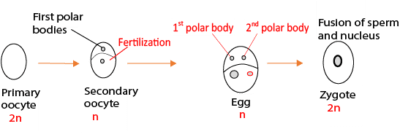
Oogenesis in human

- Oogenesis occurs in the overlies of female,
- Primordial germ cells (2n) divide mitotically to form oogonia the grow into primary oocytes (2n)
- primary oocytes undergo the first meiotic division to form two haploid cells each having 23 chromosomes. One of these cells termed the secondary oocyte (n) receives almost all the cytoplasm. The other is a polar body that may disintegrate or may divide again.
- The secondary oocyte begins meiosis II and stops at metaphase II.
- Then at ovulation, it leaves the ovary and enters an oviduct where it may be approached by a sperm.
- If sperm enters the oocyte, it activates to continue meiosis II to completions. The mature egg has 23 chromosomes. Meiosis in females produces only one egg and possibly three polar bodies.
- The polar bodies are used to discard unnecessary chromosomes while retaining much of the cytoplasm in the egg.
- The cytoplasm serves as a source of nutrients to the developing embryo.


CATEGORIES General
TAGS Dr. Bbosa Science
